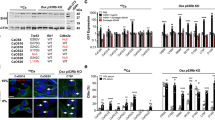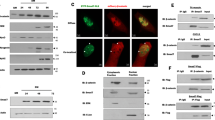Abstract
The Runx family of transcription factors plays pivotal roles during normal development and in neoplasias. In mammals, Runx family genes are composed of Runx1 (Pebp2αB/Cbfa2/Aml1), Runx2 (Pebp2αA/Cbfa1/Aml3) and Runx3 (Pebp2αC/Cbfa3/Aml2). Runx1 and Runx3 are known to be involved in leukemogenesis and gastric carcinogenesis, respectively. Runx2, on the other hand, is a common target of transforming growth factor-β1 (TGF-β1) and bone morphogenetic protein-2 (BMP-2) and plays an essential role in osteoblast differentiation. Runx2 is induced by the receptor-activated Smad; Runx2 mediates the blockage of myogenic differentiation and induces osteoblast differentiation in C2C12 pluripotent mesenchymal precursor cells. However, Smad does not directly induce Runx2 expression; an additional step of de novo protein synthesis is required. Here we report that Smad-induced junB functions as an upstream activator of Runx2 expression. Furthermore, not only the Smad pathway but also the mitogen-activated protein kinase (MAPK) cascades are involved in the induction of Runx2 by TGF-β1 and BMP-2. Our results demonstrate that following TGF-β and BMP induction, both the Smad and p38 MAPK pathways converge at the Runx2 gene to control mesenchymal precursor cell differentiation.
This is a preview of subscription content, access via your institution
Access options
Subscribe to this journal
Receive 50 print issues and online access
$259.00 per year
only $5.18 per issue
Buy this article
- Purchase on Springer Link
- Instant access to full article PDF
Prices may be subject to local taxes which are calculated during checkout






Similar content being viewed by others
References
Chalaux E, Lopez-Rovira T, Rosa JL, Bartrons R, Ventura F . 1998 J. Biol. Chem. 273: 537–543
Chiu R, Angel P, Karin M . 1989 Cell 59: 979–986
Derynck R, Akhurst RJ, Balmain A . 2001 Nat. Genet. 29: 117–129
Ducy P . 2000 Dev. Dyn. 219: 461–471
Ducy P, Zhang R, Geoffroy V, Ridall AL, Karsenty G . 1997 Cell 89: 747–754
Fujii M, Takeda K, Imamura T, Aoki H, Sampath TK, Enomoto S, Kawabata M, Kato M, Ichijo H, Miyazono K . 1999 Mol. Biol. Cell. 10: 3801–3813
Gallea S, Lallemand F, Atfi A, Rawadi G, Ramez V, Spinella-Jaegle S, Kawai S, Faucheu C, Huet L, Baron R, Roman-Roman S . 2001 Bone 28: 491–498
Hanafusa H, Ninomiya-Tsuji J, Masuyama N, Nishita M, Fujisawa J, Shibuya H, Matsumoto K, Nishida E . 1999 J. Biol. Chem. 274: 27161–27167
Heldin CH, Miyazono K, ten Dijke P . 1997 Nature 390: 465–471
Hogan BL . 1996 Genes Dev. 10: 1580–1594
Jonk LJ, Itoh S, Heldin Ch, ten Dijke P, Kruijer W . 1998 J. Biol. Chem. 273: 21145–21152
Katagiri T, Yamaguchi A, Komaki M, Abe E, Takahashi N, Ikeda T, Rosen V, Wozney JM, Fujisawa-Sehara A, Suda T . 1994 J. Cell Biol. 127: 1755–1766
Komori T, Yagi H, Nomura S, Yamaguchi A, Sasaki K, Deguchi K, Shimizu Y, Bronson RT, Gao YH, Inada M, Sato M, Okamoto R, Kitamura Y, Yoshiki YS, Kishimoto T . 1997 Cell 89: 755–764
Lee B, Thirunavukkarasu K, Zhou L, Pastore L, Baldini A, Hecht J, Geoffroy V, Ducy P, Karsenty G . 1997 Nat. Genet. 16: 307–310
Lee KS, Kim HJ, Li QL, Chi XZ, Ueta C, Komori T, Wozney JM, Kim EG, Choi JY, Ryoo HM, Bae SC . 2000 Mol. Cell. Biol. 20: 8783–8792
Lian JB, Stein GS . 1995 Iowa Orthop. J. 15: 118–140
Li QL, Ito K, Sakakura C, Fukamachi H, Inoue K, Chi XZ, Lee KY, Nomura S, Lee CW, Han SB, Kim HM, Kim WJ, Yamamoto H, Yamashita N, Yano T, Ikeda T, Itohara S, Inazawa J, Abe T, Hagiwara A, Yamagishi H, Ooe A, Kaneda A, Sugimura T, Ushijima T, Bae SC, Ito Y . 2002 Cell 109: 113–124
Look AT . 1997 Science 278: 1059–1064
Massague J . 1998 Annu. Rev. Biochem. 67: 753–791
Mundlos S, Otto F, Mundlos C, Mulliken JB, Aylsworth AS, Albright S, Lindhout D, Cole WG, Henn W, Knoll JH, Owen MJ, Mertelsmann R, Zabel BU, Olsen BR . 1997 Cell 89: 773–779
Nishimura R, Kato Y, Chen D, Harris SE, Mundy GR, Yoneda T . 1998 J. Biol. Chem. 273: 1872–1879
Noguchi K, Yamana H, Kitanaka C, Mochizuki T, Kokubu A, Kuchino Y . 2000 Biochem. Biophys. Res. Commun. 267: 221–227
North T, Gu TL, Stacy T, Wang Q, Howard L, Binder M, Marin-Padilla M, Speck NA . 1999 Development 126: 2563–2575
Okuda T, van Deursen J, Hiebert SW, Grosveld G, Downing JR . 1996 Cell 84: 321–330
Olive M, Krylov D, Echlin DR, Gardner K, Taparowsky E, Vinson C . 1997 J. Biol. Chem. 272: 18586–18594
Otto F, Thornell AP, Crompton T, Denzel A, Gilmour KC, Rosewell IR, Stamp GW, Beddington RS, Mundlos S, Olsen BR, Selby PB, Owen MJ . 1997 Cell 89: 765–771
Reimold AM, Grusby MJ, Kosaras B, Fries JW, Mori R, Maniwa S, Clauss IM, Collins T, Sidman RL, Glimcher MJ, Glimcher LH . 1996 Nature 379: 262–265
Roberts AB, Flanders KC, Kondaiah P, Thompson NL, Obberghen-Schilling E, Wakefield L, Rossi P, de Crombrugghe B, Heine U, Sporn MB . 1988 Recent Prog. Horm. Res. 44: 157–197
Sambrook J, Frisch EF, Maniatis T . 1988 Molecular cloning: a laboratory manual 2dn edn Cold Spring Harbor, NY: Cold Spring Harbor Laboratory Press
Vaillant F, Blyth K, Terry A, Bell M, Cameron ER, Neil J, Stewart M . 1999 Oncogene 18: 7124–7134
Wozney JM, Rosen V, Celeste AJ, Mitsock LM, Whitters MJ, Kriz RW, Hewick RM, Wang EA . 1988 Science 242: 1528–1534
Xiao G, Jiang D, Thomas P, Benson MD, Guan K, Karsenty G, Franceschi RT . 2000 J. Biol. Chem. 275: 4453–4459
Xiao ZS, Hinson TK, Quarles LD . 1999 J. Cell Biochem. 74: 596–605
Yamamoto N, Akiyama S, Katagiri T, Namiki M, Kurokawa T, Suda T . 1997 Biochem. Biophys. Res. Commun. 238: 574–580
Yokomizo T, Ogawa M, Osato M, Kanno T, Yoshida H, Fujimoto T, Fraser S, Nishikawa S, Okaa H, Satake M, Noda T, Nishikawa S, Ito Y . 2001 Genes Cells 6: 13–23
Zhang YW, Yasui N, Ito K, Huang G, Fujii M, Hanai J, Nogami H, Ochi T, Miyazono K, Ito Y . 2000 Proc. Natl. Acad. Sci. USA 97: 10549–10554
Acknowledgements
This work was supported by a grant to S-C Bae from the Molecular Medicine Research Group Program (M1-0106-00-0064) of the Ministry of Science and Technology of Korea. This work was also supported by Korean Research Foundation grant KRF-2001-042-D0067.
Author information
Authors and Affiliations
Corresponding author
Rights and permissions
About this article
Cite this article
Lee, KS., Hong, SH. & Bae, SC. Both the Smad and p38 MAPK pathways play a crucial role in Runx2 expression following induction by transforming growth factor-β and bone morphogenetic protein. Oncogene 21, 7156–7163 (2002). https://doi.org/10.1038/sj.onc.1205937
Received:
Revised:
Accepted:
Published:
Issue Date:
DOI: https://doi.org/10.1038/sj.onc.1205937
Keywords
This article is cited by
-
The role of WWP1 and WWP2 in bone/cartilage development and diseases
Molecular and Cellular Biochemistry (2024)
-
TGF-β1/Smad3 Signaling Is Required to Alleviate Fluoride-Induced Enamel Hypomineralization
Biological Trace Element Research (2024)
-
Single-cell RNA sequencing in orthopedic research
Bone Research (2023)
-
Exopolysaccharide of Enterococcus faecium L15 promotes the osteogenic differentiation of human dental pulp stem cells via p38 MAPK pathway
Stem Cell Research & Therapy (2022)
-
Protective role of small extracellular vesicles derived from HUVECs treated with AGEs in diabetic vascular calcification
Journal of Nanobiotechnology (2022)



